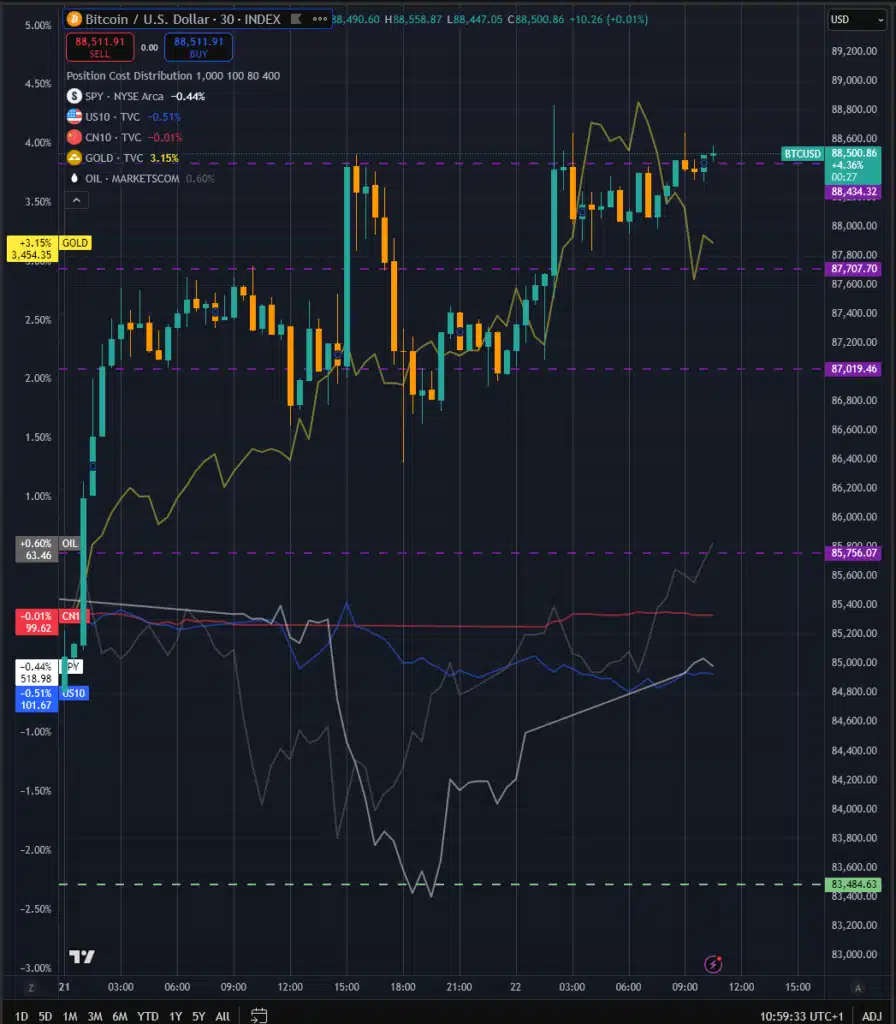Bitcoin Soars Past Gold as Tariffs Hit Solar Panels
0
0

Bitcoin surged over $94,000, outpacing gold’s rally and underscoring a renewed investor tilt toward hard assets amid mounting global trade tensions and policy uncertainty. Bitcoin rallied 4.4% ahead of 3.5% gold growth when trading hit $3,445 per ounce after multiple worldwide changes impacted markets.
The US government in Washington started strict import rules of 3,521% on solar panels entering from Southeast Asia. They claimed Chinese companies evaded US tariffs by sending their items through Vietnam, Cambodia, Malaysia, and Thailand. The BBC News report about the new tariffs sparked marketplace uncertainty and restarted global trade disputes.
Bitcoin Tracks Gold in Asia-Led Trading Surge

Unlike previous risk-on reactions, the concurrent rally in Bitcoin and gold points to a broader pivot toward inflation-hedging assets. The upward movement of BTC from the U.S. late hours into Asian trading time tracked parallel to gold prices, which approached $3,500 during Asian market hours.
The stock market maintained a protective posture during the same period. The market reacted by lowering S&P 500 futures value by 0.51% because rising bond yields demonstrate increased caution toward traditional asset classes.
The U.S. 10-year Treasury note price dropped and 10-year yields increased by seven basis points to 4.49% during this period while Chinese 10-year bond prices stayed unchanged at 2.33%. This narrowing shows clear conflicts between respective inflation expectations.

Rising Tariffs Hit Miners, Add Fuel to Bitcoin Rally
The +0.78 correlation between Bitcoin and gold during the period of analysis shows that analysts consider BTC an emerging macro hedge asset. The data reveals that BTC moved independently from standard safe assets even as equities and bonds both declined.
The recent tariff information affected the digital mining sector for cryptocurrencies as well. U.S. crypto miners need solar power more than ever to operate their facilities in states like Texas and Kentucky but rising panel prices will reduce their profits. Mounting supply-chain pressures and energy policy difficulties could have led people to buy more BTC because raised operating costs needed offsetting.
During Asia’s market run BTC futures contracts attracted strong buying interest that jumped 8% as reported by CME Group data. This shows that investors committed to BTC took part while equity spill-over stayed minimal. The market monitored the price levels $87,019, $87,707, and $$94,000 to find next potential buying zones, with $94,000 seen as crucial for pushing the price higher.
Oil Lags Behind as Bitcoin and Gold Surge

Oil maintained its separate path from other expanding asset classes. West Texas Intermediate crude increased 0.57 dollars before ending at 64 dollars per barrel for June delivery following its 18-month low on Monday. Research professionals see this buying pattern merely as a stabilization of market conditions without any link to the idea of crypto as an inflation hedge.
The White House Chief returned to criticize the work of Fed Chairman Jerome Powell in the financial markets. His demand to lower interest rates today exposed feelings about central bank independence, which fueled bond market downturns and made alternative financial choices more attractive.
Bitcoin Trading Patterns Signal Growing Asian Influence
Current BTC movements show that Asian investors mostly determine cryptocurrency prices today. Since the ETF launch patterns, most moves now start at Asian trading hours, especially during Singapore and Hong Kong sessions. The crypto market’s shift demonstrates a change in how different groups handle its liquidity and trading direction.
Bitcoin’s new market characteristics show through its relationships with different asset classes. During this time frame its negative 0.26 correlation to the SPDR S&P 500 ETF (SPY) shows Bitcoin is moving away from equity markets in surprising behavior that contrasts with gold and Treasuries.
Conclusion
Bitcoin’s rally highlights shifting investor behavior amid trade tensions and macro uncertainty. When tariffs disrupt supply chains and energy prices increase BTC stands out from other investments while showing more similarity to gold as a safe landing point. The region leads the world in boosting the development of crypto trading markets.
Follow us on Twitter and LinkedIn, and join our Telegram channel to be instantly informed about breaking news!
FAQs
1. Why did BTC rise more than gold?
Tariffs on Asian solar panels sparked inflation fears, boosting demand for BTC as a hedge.
2. How do the tariffs affect BTC mining?
Higher solar panel costs may raise mining expenses, pressuring U.S. miners and supporting Bitcoin’s price.
3. What does Bitcoin’s asset correlation show?
BTC is acting more like gold, showing hedge behavior and moving away from stocks and bonds.
Glossary Of Key Terms
Tariff: A tax on imported goods, used to regulate trade.
Hard-Asset Preference: Investors favor assets like BTC and gold during uncertainty.
S&P 500 (SPY): Index tracking the top 500 U.S. companies.
Value-at-Risk (VaR): A risk measure for portfolio losses.
Risk-On Move: A market condition where investors seek higher-risk assets.
Federal Reserve (Fed): The U.S. central bank that sets monetary policy.
Central Bank Independence: The ability of central banks to make decisions without political influence.
Reference
Read More: Bitcoin Soars Past Gold as Tariffs Hit Solar Panels">Bitcoin Soars Past Gold as Tariffs Hit Solar Panels
0
0
 Manage all your crypto, NFT and DeFi from one place
Manage all your crypto, NFT and DeFi from one placeSecurely connect the portfolio you’re using to start.








